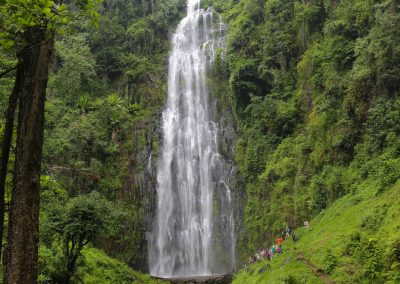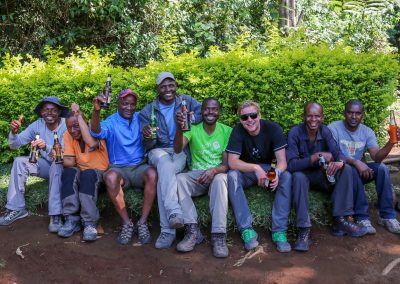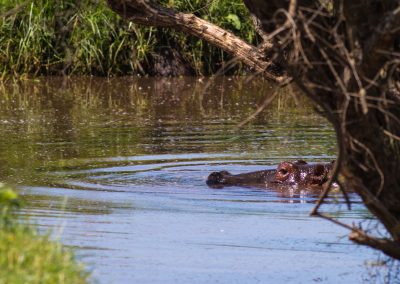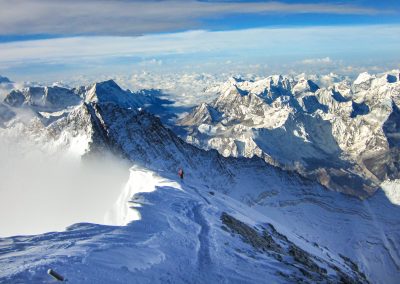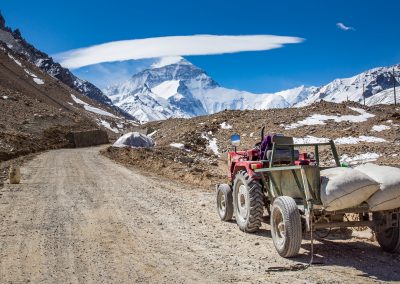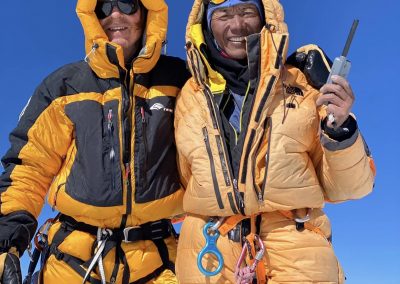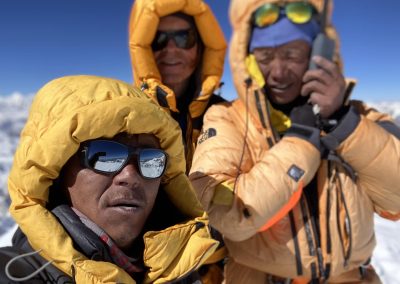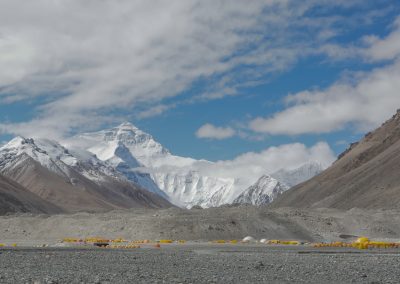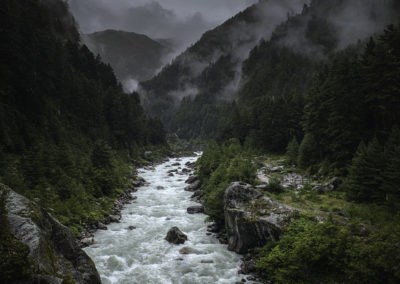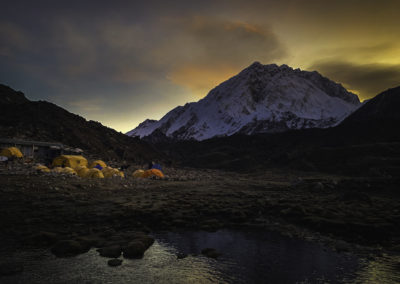Join us to the heart of the Himalayas and hike among the world’s highest mountains. We have arranged trips to the Himalayas for over 15 years and are happy to help you choose an adventure depending on your wishes. The number of hikes per year is limited.
Before each trip, we go through equipment lists, training schedules, itinerary and other things together. Safety and planning are the most important parts of a successful expedition, and some of our tours require previous experience. In addition to our ready-made packages, you always have the opportunity to have a tailor-made solution. Feel free to contact us via the questionnaire on the website for further information.
Kilimanjaro – 5895m
About
The highest point in Africa, Kilimanjaro, is perhaps one of the best-known mountains in the world. It is the easiest of the Seven Summits and definitely the most romantic!
Kilimanjaro is like an island, standing tall and sentinel surrounded by the hot, dry plains of Tanzania. An expedition to climb the world’s highest free-standing mountain is a veritable smorgasbord of African culture and scenery, providing a fabulous excuse to visit this wild continent.
Kilimanjaro was one of the first mountains I climbed, and I was captivated immediately. The combination of the beautiful scenery, the people, and the wildlife is unbeatable!
Date and price
The best time to climb Kilimanjaro is during the dry seasons when the weather is more stable and clear. This is typically during the dry seasons, which extend from December to March and from June to October. During these months, there is less rain and fewer clouds, providing better views and more comfortable weather for hiking. It’s also important to avoid the rainy seasons as the trails can become muddy and slippery, making the climb more challenging and less safe.

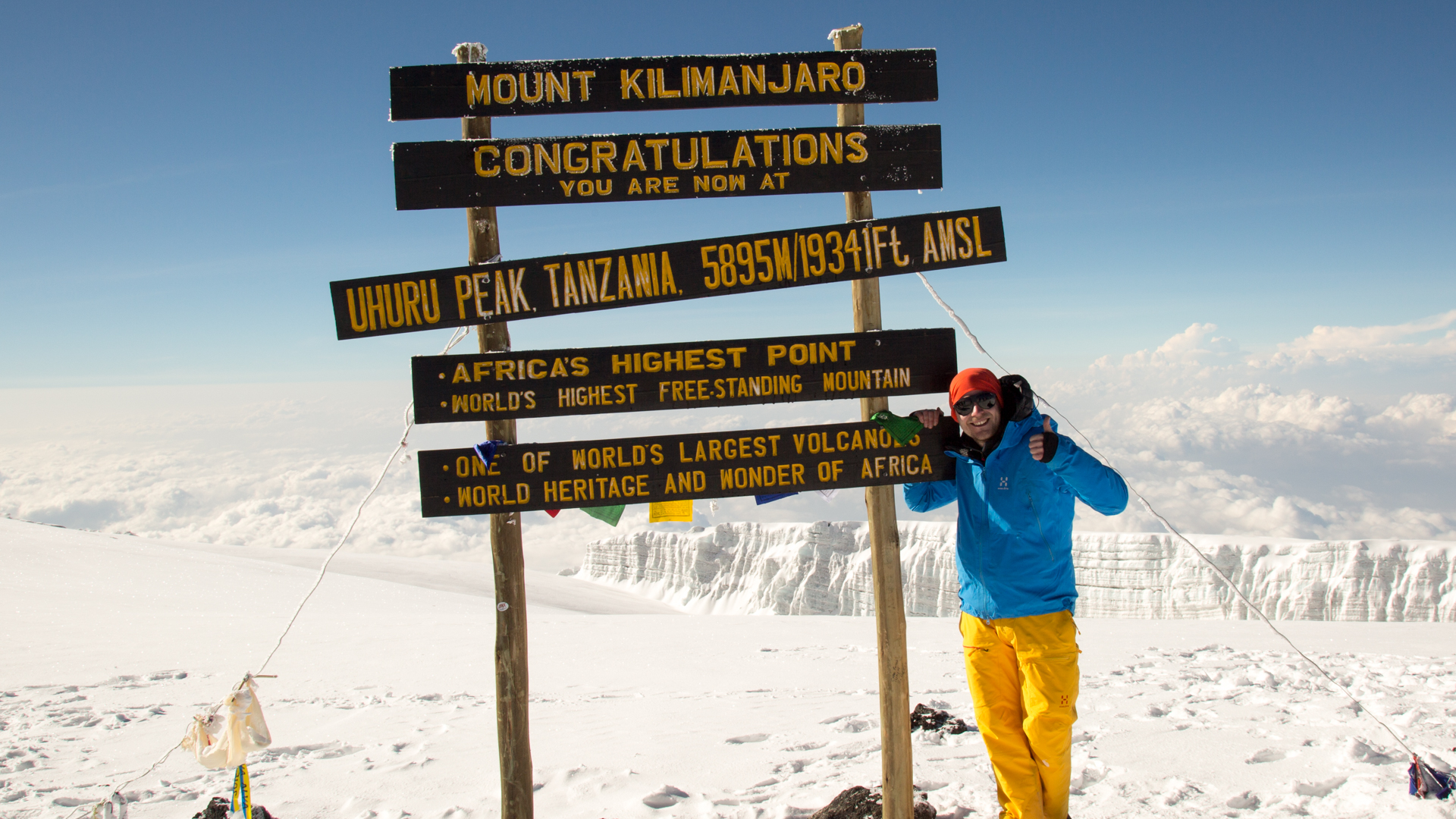
Day 1
Arrival
The group arrives at Kilimanjaro Airport (JRO). Participants are met by our representative and transferred to a Aishi Machame hotel, which is beautifully situated on the slopes of Mount Kilimanjaro.
Day 2
Materuni Waterfall
Acclimatization day. Begin the day with a short drive up onto the slopes of Kilimanjaro, to the village of Materuni, approximately 1,800 m above sea level. This lush rainforest region is known for producing some of the best coffee in East Africa. Start the day with a visit to a small coffee farm and learn about how the coffee is grown, harvested and processed locally. Try your own hand at processing, roasting and preparing a fresh cup of coffee in the local Chagga way
Once you have finished enjoying your coffee break, you will depart on a beautiful 45 minute hike through the hills and valleys en route to the waterfalls. Along the way your guide will teach you about local plants and how they are used for food and traditional medicine, as well as giving you more insight into the local Chagga culture.
The waterfalls are hidden in a pristine valley with cliffs towering up to 200ft overhead. The water falls straight down in a curtain to land in a small pool where you can relax, take lunch and go for a swim in the chill mountain waters.
After the falls hike you will return back to the car and return to the hotel
Day 3
Machame Camp
A guide and a mountain support crew will arrive at the hotel in the morning in order to meet you and hold a quick briefing, after which you will travel by vehicle to Kilimanjaro National Park’s entrance: Machame Gate (1,800 m). After the quick formality of acquiring climbing permits and registering with the search and rescue service, the group will start trekking up toMachame Camp (3,010 m). The trekking route includes passage through the rainforest (where tropical showers are highly probable), so we recommend you take not only spare clothes, but also your raincoats.
Day 4
Shira Camp
After breakfast you will start trekking up to the second high-altitude camp, Shira Camp (3,845 m). On this day you will emerge from the rainforest and for the first time be able to see stunning views of the Shira Plateau laid out in front of you. Physically speaking, the trekking is not very difficult, but you may feel the changes in altitude, so pay attention to your body and remember that choosing the proper pace is extremely important for good trekking. When you reach the camp, you will have lunch and some rest, after which the group will go on an acclimatization hike towards Lava Tower Camp with a 300-meter gain in altitude. Back down at Shira Camp you will be served a hot dinner.
Day 5
Barranco Camp
After breakfast you will leave Shira Camp (3,845 m) and start your way to the key point of the route: Lava Tower (4,630 m). This section of the route has a lot of ascents and descents that end in a camp at over 4,600 meters. It might be difficult, and you may feel some discomfort, but in order to successfully acclimate to the altitude you have to spend at least 1–2 hours here, so this is where lunch will be.
Then you will descend to Barranco Camp (3,960 m). Here you can see the famous Barranco Wall, impressive in both its massive size and steepness! Next day you will be climbing it, but don’t worry: it features a very simple hiking trail.
Day 6
Karanga Camp
On this day it is best to make an early start to avoid crowding on the way up Barranco Wall. Despite the Wall’s seemingly daunting height and steepness the actual climb is rather merciful at a mere hour or so. The top provides a great photo opportunity with Kibo Peak as the backdrop.
The next part of the day is rife with ups and downs where your guides will choose the best place for individual climbers. A lunch break at Karanga Camp shall be followed by an acclimatization climb towards Barafu with its highest point being 4,270m. The group then drops back to Karanga Camp for the overnight.
Day 7
Barafu Camp
After breakfast you begin your way to Barafu Summit Camp (4,640 m). Our team will set up a camp for you ahead of time, including tents and sleeping bags, so you can relax. After regaining strength, you have to complete an acclimatization climb towards the intermediate Kosovo Summit Camp with its highest point being 4,800 m and then back to Barafu Camp, where you will be served a hot dinner. It is better to spend the remainder of the day resting and sleeping before night summiting.
Day 8
Summit – Uhuru Peak!
Summiting starts around midnight from 4,635 m, ending on Uhuru Peak at 5,895 m. While the trek itself is fairly simple, rarified mountain air does pose a challenge. Therefore, a guide who will monitor their condition throughout the climb shall accompany every two climbers ensuring safety above all. Upon summiting, you shall have an opportunity to walk on the nearby glacier.
The descent to 3,820 m at Millennium Camp starts after a two-hour rest back at Barafu Camp.
Day 9
Mweka Gate
The camp is situated in a tropical rainforest. When you wake up, you will feel relief from the reduction of the height and the satisfaction of reaching the summit. After a warm breakfast, you will head for the park’s exit: Mweka Gate (1,640 m). After your descent the whole group will gather to congratulate you, followed by offering you a chance to share your opinions on the climb in the guestbook. Provide you a transfer back to the hotel. Upon completing your transfer, a celebratory toast with sparkling wine awaits you at the hotel, followed by a refreshing dip in the pool. Conclude the evening with a delectable dinner and beverages at the hotel’s esteemed restaurant.
Day 10
Safari och departure
After a restful morning, you kick off your day at 10 am with a visit to African View Lodge for a delicious lunch. Fuelled up, you embark on a thrilling afternoon safari in Arusha National Park with our guides in our own private jeeps. Enjoy yourself in the park’s diverse beauty, from vast acacia savannahs to the shimmering Momella Lakes and the majestic Mount Meru, Tanzania’s second-highest peak. Keep your eyes peeled for fascinating wildlife like monkeys, zebras, giraffes, waterbuck, and buffalo. With a bit of luck, you might even spot a majestic leopard! The birding here is incredible, with over 400 species including the iconic pink flamingos. As the day winds down, we head to the airport for a final farewell dinner before catching our flight back home.
Day 11
Arrival
Back home with the memories of a great adventure in your backpack.
Traceable jacket
Mount Everest – 8848m
About
Mount Everest North Side Expedition is one of our major regular expeditions – obviously the most popular one. We have been regularly organizing and successfully executing Everest expedition from the Tibetan side for over a decade and we are one of the few foreign expedition operators recognized by the China Tibet Mountaineering Association.
Our Everest North Side Expedition takes place every spring season – April to May. And we start it from our base in Kathmandu. Our group meets up here in the capital and after completing visa documentation we fly to Lhasa, the capital city of Tibet Autonomous Region. Keeping in mind the acclimatization schedule we take time exploring the Tibetan culture and landscape and slowly proceed towards the Everest Base Camp.
On the Tibet side, we set up three base camps: the main camp at 5200, also known as the Chinese Base Camp, Intermediate Camp at 5800m and the Advance Base Camp at 6400m. Each of these camps are well equipped to provide comfort and quality service to our expedition members. While some of our expedition sherpas set up the three high camp : Camp1 at 7000m, Camp 2 at 7700m and Camp 3 at 8300 our expedition members complete at least two rounds of acclimatization schedule between Camp 1 and the Base Camp. Then as the ropes are fixed until the summit we are ready to make the summit attempt. By the end of May , as we wrap up the expedition we return by road via Kyirong.
There is a before and after an expedition to Mount Everest. This came to change my whole life.
Date and price
This expedition is available during the spring when the weather conditions are most favorable. Prices are subject to currency exchange rates and prevailing conditions. For current pricing, please contact us using the form provided below.

Day 1
Arrival in kathmandu and transfer to hotel
Your arrival in Kathmandu marks the start of our expedition. We will receive you at Tribhuvan International Airport and transfer you to your hotel. Then you have free time to refresh. We meet up again in the evening for a welcome dinner and an introduction with the remaining expedition members.
Day 2-4
In Kathmandu for Tibet/China visa processing
In the morning, on the second day, we will pick up your passports and submit them at the Chinese Embassy in Kathmandu for Tibet visa application, which takes three working days to process. While we wait for our visas we utilize this time visiting cultural heritage sites around Kathmandu; also we do a thorough check of your personal climbing gears and purchase/rent if required.
Day 5
Flight to Lhasa
Our entry point in Tibet is usually the Lhasa city. We take a direct flight from Kathmandu to the Lhasa Gongar Airport and drive to Lhasa city. Lhasa is the capital city of the Tibet Autonomous Region of Tibet, China and it is famous for the Potala Palace and big monastic institutions.
Day 6
In Lhasa to acclimatize and explore
We stay one day more at Lhasa as part of acclimatization and utilize the time by exploring Lhasa – visiting the famous Potala Palace, the Jokhang Temple and the Barkhor Street.
Day 7
Drive to Shigatse
After spending two days in Lhasa, exploring the Tibetan cultural heritage sites, and the bustling new modern developments, we head southwest towards the second-largest city in Tibet – Shigatse. The road trip between Lhasa and Shigatse offers some amazing scenery of any road in the world. Before arriving in Shigatse we cross over a 5000m. pass called Karo La Pass.
Shigatse means ‘ the fertile land’ in the local Tibetan language. And as the name goes by it covers one of the major cultivable lands across Tibet.
Day 8
Drive to Xegar
Shigatse is also known for one of the most important monasteries in Tibet – the Tashi Lunpu Monastery, the seat of the Panchen Lama, who is believed to be the second-highest incarnation after the Dalai Lama. So, we visit the monastery in the morning before heading towards Xegar.
Xegar is a newly developed small town area, with better accomodation compared to Tingri.
Day 9
In Xegar for acclimatization
We spend one more day at Xegar. To acclimatize we hike to a nearby high point and descend back.
Day 10
Drive to Everest Base Camp
Today we drive from Xegar to Everest Base Camp. We pass by Tingri on the way.
Day 11-15
At Everest Base Camp
We spend a few days at our main base camp to acclimatize and make finish preparation for further camps – transferring logistics by yaks and setting up the intermediate and advance base camps. Also, we conduct the puja ceremony before moving ahead.
Day 16
Trek to Intermediate Camp
Day 17
Trek to Advance Base Camp
Day 18-23
At ABC – Acclimatize and first rotational climb to North Col
The Advance Base Camp is the second base for the Northside expedition. During these few days at ABC, we acclimatize and make our first climbing rotation to North Col.
Dag 24-28
At Everest Base Camp
After our first rotation up to ABC and North Col we descend back to Everest Base Camp and stay few days for rest. Meantime, our Sherpa team establish Camp2.
Dag 29-35
Second Rotation of Climbing
After few days of rest at EBC we begin second rotation of climbing. Moving gradually to Interim Camp, ABC and North Col we climb up to Camp2 and descend back to ABC.
Dag 36-40
At Everest Base Camp
After completing our second rotational climb up to Camp 2, we descend to Everest Base Camp for rest and prepare for the summit climbing attempt. Meantime, our Sherpa team establish Camp 3, also called the last camp.
Day 41-52
Summit Attempt
While we rest and prepare for the summit attempt, the rope fixing team completes their task; and based on the best weather window we launch our Summit climb.
- Summit Attempt Day 1: Move to Interim Camp
- Summit Attempt Day 2&3: Move to ABC
- Summit Attempt Day 4: Climb to North Col
- Summit Attempt Day 5: Climb to Camp 2
- Summit Attempt Day 6: Climb to Camp 3
- Summit Attempt Day 7: Summit and descend to North Col
- Summit Attempt Day 8: Descend to ABC
- Day 9: Trek back to Everest Base Camp
Day 53-54
Everest Base Camp
At Everest Base Camp for rest and wrapping up our expedition camp; report our climbing details to the liaison officer and receive a summit certificate.
Day 55
Drive to Kyirong
We exit Tibet by road from Kyirong.
Day 56
Cross Tibet-Nepal border and drive to Kathmandu
In the morning we take a short drive up to China-Nepal border at Kyirong and arrive in Timure, Nepal. Then we take a jeep all the way back to Kathmandu.
Day 57
In Katmandu: free day
Free day in Kathmandu for rest and recovery. We meet up in the evening for a farewell dinner and celebrate our expedition.
Day 58
Transfer to airport for international departure
Transfer to the airport in Kathmandu around 2-3 hours before your scheduled departure.


Björn Lindwall
Entrepreneur - summited Everest May 18th 2018
Chhiring Dorje Sherpa and Robin Trygg have been invaluable in my quest to reach the top of the world. With their assistance, I realized my dream and stood on the world’s highest peak!

Erik Åkerberg
Broker - summited Everest May 21th 2017
I stood on the summit of Mount Everest in the spring of 2017, and it was an incredible experience. I highly recommend Trygga Resor, who provided me with the right conditions to succeed. They took care of logistics, administration, and planning, which was incredibly valuable. Thank you!

Annelie Pompe
Adventurer - summited Everest May 24th 2011
Chhiring is someone you always want by your side when climbing the world’s highest mountains. With his knowledge and inspiring personality, we had an unforgettable journey to the top of Mount Everest.
Traceable jacket
Cho Oyu 8201m
About
Cho Oyu is the world’s sixth-highest peak. Situated at the border between Tibet and Nepal and just west to Everest – Cho Oyu was first climbed on October 19, 1954, by members of an Austrian Expedition. Ever since it has drawn the interest of many high altitude adventurers and it has become one of the most popular 8000m. mountain.
The best suitable time to climb Cho Oyu is in the Autumn (September/October) and in the Spring (April/May). The normal climbing route is from the Tibet side – the North West Ridge. This route is considered to be of lesser technical difficulty and risks. Yet, it is still a big mountain and climbing it is a challenge in itself.
Cho Oyu is perfect for those who have already climbed mountains in the Himalayas and now want to try climbing a mountain over 8000m.
I´ve summited Cho Oyu many times since I first got here in spring 1996.
Date and price
This expedition takes place during the climbing seasons in spring/autumn when the weather is most favorable. Prices may vary depending on the exchange rater and permits. For current pricing, please contact us using the form below.
Day 1
Arrival in Kathmandu
Your arrival in Kathmandu marks the start of our expedition. We will receive you at Tribhuvan International Airport and transfer you to your hotel. Then you have free time to refresh. We meet up again in the evening for a welcome dinner and an introduction with the remaining expedition members.
Day 2-4
In Kathmandu for Tibet/China visa processing
In the morning, on the second day, we will pick up your passports and submit them at the Chinese Embassy in Kathmandu for Tibet visa application, which takes three working days to process. While we wait for our visas we utilize this time visiting cultural heritage sites around Kathmandu; also we do a thorough check of your personal climbing gears and purchase/rent if required.
Day 5
Flight to Lhasa
Our entry point in Tibet is usually the Lhasa city. We take a direct flight from Kathmandu to the Lhasa Gongar Airport and drive to Lhasa city. Lhasa is the capital city of the Tibet Autonomous Region of Tibet, China and it is famous for the Potala Palace and big monastic institutions.
Day 6
In Lhasa to acclimatize and explore
We stay one day more at Lhasa as part of acclimatization and utilize the time by exploring Lhasa – visiting the famous Potala Palace, the Jokhang Temple and the Barkhor Street.
Day 7
Drive to Shigatse
After spending two days in Lhasa, exploring the Tibetan cultural heritage sites, and the bustling new modern developments, we head southwest towards the second-largest city in Tibet – Shigatse. The road trip between Lhasa and Shigatse offers some amazing scenery of any road in the world. Before arriving in Shigatse we cross over a 5000m. pass called Karo La Pass.
Shigatse means ‘ the fertile land’ in the local Tibetan language. And as the name goes by it covers one of the major cultivable lands across Tibet.
Day 8
Drive to Tingri (4350m)
Shigatse is also known for one of the most important monasteries in Tibet – the Tashi Lunpu Monastery, the seat of the Panchen Lama, who is believed to be the second-highest incarnation after the Dalai Lama. So, we visit the monastery in the morning before heading towards Tingri.
Tingri is an old Tibetan settlement area situated above 4000m. which is a must-stop-by place before heading toward Cho Oyu base camp.
Day 9
In Thingri for acclimatization
We spend one more day at Tingri for acclimatization and for some last-minute preparation – shopping groceries. As part of the acclimatization, we hike to a nearby hill, from where we can see Cho Oyu and Everest.
Day 10
Drive to Cho Oyu Base Camp (5200m)
Now, there is road access up to Cho Oyu Base Camp. The drive from Tingri takes around 3 hours by jeep.
Day 11-13
At ChoOyu Base Camp
The Cho Oyu base camp is also called the Chinese Base Camp. We camp and stay two days here for preparing loads and transport them on Yaks.
Day 14
Trek to Intermediate Camp (Gyablung)
Today we trek to the Intermediate Camp at Palum for an overnight camp. A Chinese military camp is present at Palum near the interim camp. Passport documents are checked here.
Day 15
Trek to Advance Base Camp
We trek on the moraine trail of the Gyabrag Glacier and arrive at Advance Base Camp. This trail used to be the old trade route over Nangpa La pass, which was used by local Tibetans and the Sherpas of the Khumbu region.
Day 16-20
At Advance Base Camp
The Advance Base Camp is our main base for Cho Oyu. During these first few days at ABC , we acclimatize and prepare for climbing rotation. Also, we perform the puja ceremony for our expedition, and the Sherpa team set up route up to Camp1 – 6400m.
Day 21-30
Climbing Rotations
As we finish our preparations at ABC, we start our climbing rotations. There will be two climbing rotations to higher camps. First rotation up to Camp1; second rotation up to Camp 2 and above.
Day 31-36
Summit Attempt
while members complete their climbing rotations, Sherpa rope-fixing team establish camp 3 (7500m) and opens route up to the Summit. Then, we wait for the best weather window and launch a summit attempt from ABC.
Summit Attempt Day 1: ABC to Camp 1
Summit Attempt Day 2: Camp 2
Summit Attempt Day 3: Camp 3
Summit Attempt Day 4: Summit and descend to Camp1
Summit Attempt Day 5: Descend to ABC
Day 37
Advance Base Camp Clearance
At Advance Base Camp for wrapping up our camp.
Day 38
Trek to Interim Camp and drive to Tingri
There is off-road access up to Interim Camp. So, we trek up to Palum and drive to Tingri the same day.
Day 39
Drive to Kyirong (2700m)
We exit Tibet by road from Kyirong.
Day 40
Cross Tibet-Nepal border and drive to Kathmandu
In the morning we take a short drive up to China-Nepal border at Kyirong and arrive in Timure, Nepal. Then we take a jeep all the way back to Kathmandu.
Day 41
In Katmandu: free day
Free day in Kathmandu for rest and recovery. We meet up in the evening for a farewell dinner and celebrate our expedition.
Day 42
Transfer to airport for international departure
Transfer to the airport in Kathmandu around 2-3 hours before your scheduled departure.

Traceable jacket
Himlung Himal 7126m
About
Located in the Nar-Phu village, also known as ‘Himalparikaogaon,’ translating to a village on the other side of the mountain, Mount Himlung was not an easy choice due to its remote access. Official permission to climb was granted by the Government of Nepal only from 1992. However, today, Himlung Himal stands out as one of the most appealing and achievable 7000m mountains. Unlike other technical peaks like Nuptse, Himlung presents fewer technical challenges and objective dangers.
Trygga Resor organizes expeditions to Himlung during the autumn season, typically in September/October, which is considered the best time to climb. This peak is ideal for those seeking a manageable high-altitude mountaineering experience, as well as climbers aiming to prepare for Everest or other eight-thousand-meter peaks.
A memory for life! To share this together with an awesome gang is something I will always remember.
A fun and slightly unusual mountain to climb, perfect for those who one day ant to reach over 8000m. Getting to the mountain is an experience in itself with all the villages and people you pass along the way.
A fantastic climb on a mountain above 7000m. I am looking forward seeing you!
Date and price
Trygga Resor organizes expeditions to Himlung in the autumn season – September/October. This is the best time to climb Himlung. For further information, pleace use the contact sheet below.
Day 1
Arrival Kathmandu and transfer to your hotel.
Day 2
Sightseeing och preparations in Kathmandu.
Day 3
Drive to Besisahar.
.
Day 4
Drive to Koto.
Day 5
Trek starts from Koto to Meta.
Day 6
Trek to Kyang.
Day 7
Trek from Kyang to Phu Gaun.
Day 8
Rest & Acclimatization in Phu Gaun.
Day 9
Trek to Himlung Basecamp.
Day 10
Rest at BC, preparations for climbing.
Day 11
Rest at BC, preparations for climbing.
Day 12
Rest at BC, preparations for climbing.
Day 13
Start our climbing rotation to higher camps – climb to Camp 1 (5450m), Camp 2 (6000m) and climb a bit higher and descend to base camp.
Day 14
Start our climbing rotation to higher camps – climb to Camp 1 (5450m), Camp 2 (6000m) and climb a bit higher and descend to base camp.
Day 15
Start our climbing rotation to higher camps – climb to Camp 1 (5450m), Camp 2 (6000m) and climb a bit higher and descend to base camp.
Day 16
While we rest at the base camp after our acclimatization climbing rotation, our Sherpa team establish Camp 3 at 6350m. and finish rope fixing up to Summit. Then, on the best weather window, we launch the summit attempt from the base camp.
Day 17
While we rest at the base camp after our acclimatization climbing rotation, our Sherpa team establish Camp 3 at 6350m. and finish rope fixing up to Summit. Then, on the best weather window, we launch the summit attempt from the base camp.
Day 18
While we rest at the base camp after our acclimatization climbing rotation, our Sherpa team establish Camp 3 at 6350m. and finish rope fixing up to Summit. Then, on the best weather window, we launch the summit attempt from the base camp.
Day 19
While we rest at the base camp after our acclimatization climbing rotation, our Sherpa team establish Camp 3 at 6350m. and finish rope fixing up to Summit. Then, on the best weather window, we launch the summit attempt from the base camp.
Day 20
While we rest at the base camp after our acclimatization climbing rotation, our Sherpa team establish Camp 3 at 6350m. and finish rope fixing up to Summit. Then, on the best weather window, we launch the summit attempt from the base camp.
Day 21
While we rest at the base camp after our acclimatization climbing rotation, our Sherpa team establish Camp 3 at 6350m. and finish rope fixing up to Summit. Then, on the best weather window, we launch the summit attempt from the base camp.
Day 22
While we rest at the base camp after our acclimatization climbing rotation, our Sherpa team establish Camp 3 at 6350m. and finish rope fixing up to Summit. Then, on the best weather window, we launch the summit attempt from the base camp.
Day 23
While we rest at the base camp after our acclimatization climbing rotation, our Sherpa team establish Camp 3 at 6350m. and finish rope fixing up to Summit. Then, on the best weather window, we launch the summit attempt from the base camp.
Day 24
While we rest at the base camp after our acclimatization climbing rotation, our Sherpa team establish Camp 3 at 6350m. and finish rope fixing up to Summit. Then, on the best weather window, we launch the summit attempt from the base camp.
Day 25
While we rest at the base camp after our acclimatization climbing rotation, our Sherpa team establish Camp 3 at 6350m. and finish rope fixing up to Summit. Then, on the best weather window, we launch the summit attempt from the base camp.
Day 26
BC clearance and trek to Phu.
Day 27
Phu Gaon to Meta.
Day 28
Meta to Koto.
Day 29
Koto to Besisahar by jeep.
Day 30
Besisahar to Kathmandu by jeep.
Day 31
Free day in Kathmandu.
Day 32
Departure.
Traceable jacket
Mount Everest North Col 7500m
About
Embark on an unforgettable adventure to one of the world’s most iconic destinations: the North Col of Mount Everest, rising up to 7028 meters above sea level. From here we push all the way up to 7500m above sea level. This expedition takes place during the spring, the optimal season for the best weather, as many strive for the summit of Mount Everest.
With an experienced and knowledgeable guide by your side, this journey is perfect for those who have already conquered Kilimanjaro or other mountains around 6000 meters. We take care of all the details, from logistics to safety, allowing you to focus on experiencing the incredible natural beauty and conquering new challenges. Take the step beyond the ordinary and let the North Col of Mount Everest be your next extraordinary achievement!
Before reaching the summit of Mount Everest, I made this journey to the North Col. It helped me understand what was required to later make it all the way up!
It’s amazing to be part of a real Mount Everest expedition. This is the kind of thing you usually read about in books or see in movies.
I´ve been here for so many years now and it feels like home. This is a perfect trip if you want to join me for the summit later.
Date and price
This expedition takes place during the spring climbing season when the weather is most favorable. Prices may vary depending on the exchange rater and permits. For current pricing, please contact us using the form below.
Day 1
Arrival Kathmandu and transfer to your hotel.
Day 2
Sightseeing och preparations in Kathmandu. Tibet Visa Application.
Day 3
Tibet Visa Application.
Day 4
Flight to Lhasa and transfer to Hotel.
Day 5
Lhasa Sightseeing- visit Potala Palace & Jokhang Temple.
Day 6
Drive to Shigatse.
Day 7
Drive to Tingri/Xegar.
Day 8
Rest & Acclimatization in Tingri/Xegar.
Day 9
Drive to Everest Base Camp (BC).
Day 10
Rest at BC, 5200m
Day 11
Rest at BC, 5200m.
Day 12
Trek to Intermediate Camp, 5700m.
Day 13
Intermediate Camp, 5700m.
Day 14
Trek to Advance Base Camp,6400m.
Day 15
Advance Base Camp, 6400m.
Day 16
Back to Intermediate Camp, 5700m.
Day 17
Back to BC, 5200m (end of first rotation of acclimatization).
Day 18
Rest in BC, 5200m.
Day 19
Rest in BC, 5200m.
Day 20
Rest in BC, 5200m..
Day 21
Rest in BC, 5200m.
Day 22
Trek to Intermediate Camp, 5700m.
Day 23
Rest in Intermediate camp, 5700m.
Day 24
Trek to Advanced Basecamp, 6400m
Day 25
Rest in Advanced basecamp, 6400m
Day 26
Climb to North Col, 7033m.
Day 27
Touch 7,500m & back to Advance Camp, 6400m.
Day 28
Trek back to Intermediate camp, 5700m.
Day 29
Trek back to Mount Everest basläger, 5200m.
Day 30
Extra Day.
Day 31
Drive to Lhasa.
Day 32
Fly to Kathmandu.
Day 33
In Kathmandu: Free Day.
Day 34
Departure Kathmandu.
Traceable Jacket
Ramdung 5900m
About the trip
Ramdung peak is one of the most beautiful smaller peaks in Nepal. In terms of an altitude it is 5900m high, yet it is done in an expedition style, requiring to establish a base camp and high camp. It is situated in the Rolwaling valley and it is a recommended peak for those who wish to climb a reasonably easier but much interesting Himalayan peak.
TRIP HIGHLIGHTS
- Trek through the pristine Rolwaling‘ the sacred hidden valley’
- Climb the Ramdung 5900m.
- Panoramic view of the Gaurishankar Mountain Range
- View of Mount Everest 8848, ChoOyu 8201, and Shisapangma 8013m. from the summit of Ramdung
The Rolwaling valley is something special. One of earths most beautiful places.
A rare experience to visit the ”real” Nepal and its magical people and nature.
Looking forward to show people my home and birthplace. The Rolwalingvalley is really something special.
Date and price
The best time to hike in the area is during the spring and autumn when at other times there is a monsoon period with large amounts of precipitation and poor visibility. We have chosen to postpone this trip during the autumn.
Day 1
Arrival in Kathmandu and transfer to hotel.
Day 2
Sightseeing and preparations in Kathmandu.
Day 3
Drive to Chetchet, then trek to Simigaon.
Day 4
Trek to Kyalje.
Day 5
Trek to Beding.
Day 6
In Beding for rest and to acclimatize. In the morning visit Rolwaling Monastery and then short hike above Beding.
Day 7
Trek to Na.
Day 8
Hike to Tso Rolpa Lake 4600m, the largest glacial lake in the world.
Day 9
Trek to Yalung BC.
Day 10
At Base Camp to acclimatize and prepare to establish camp 1.
Day 11
At Base Camp to acclimatize and prepare to establish camp 1.
Day 12
At Base Camp to acclimatize and prepare to establish camp 1.
Day 13
Move to Camp 1.
Day 14
From the Camp 1 launch summit attempt. Summit and descend to Camp 1.
Day 15
Descend to Yalung Basecamp.
Day 16
Trek to Na.
Day 17
Trek to Dong-gang.
Day 18
Trek to Simigaon.
Day 19
Trek to Chetchet and drive to Kathmandu. Around 10 hours.
Day 20
In Kathmandu – free day.
Day 21
Leaving Kathmandu and heading home.

Traceable Jacket
Lobuche Peak 6119 m
About the trip
The goal with this trip is to stand on top of the mountain Lobuche peak and look out over a fantastic sunrise over the world’s highest mountains. In front of us we then have a fantastic view of Everest, Cho Oyu and Ama Dablam. The tour can also be combined with a hike to Mount Everest base camp and a the top of Kala Pathar, 5545m. By doing this before, you are well acclimatized and prepared for your climb to the summit of Lobuche. The mountain has two peaks, Lobuche East 6119m and Lobuche West 6135m. On our regular departures, we aim to reach Lobuche East. Before the climb, we rehearse climbing techniques in base camp so that you feel fully prepared and confident before climbing. It is a non-technical mountain, but it is a slightly bigger challenge to climb Lobuche Peak than the other ”trekking” mountains. The climb along the summit ridge up to the main peak includes fun alpine climbing with great views.
The trip starts in Nepal’s capital Kathmandu where we do some sightseeing before flying in a small twinotter airplane to the famous airstrip in Lukla. From there our trek begins that take us through countless Sherpa villages, monasteries and amazing hiking trails up to the foot of the world’s highest mountain Mount Everest and to the top of Lobuche. A memory for life.
Definitely an adventure out of the ordinary. Well organized and world class guides. A memory for life.
Climbing a mountain in the Himalayas is something few are blessed with. To also do it opposite Mount Everest with a view of some of the world’s highest mountains is unique. A rare experience.
The climbing on Lobuche is very nice. If you´ll do the east summit I promise you that I will help you reach the summit.
Date and price
The best time to climb Lobuche is during the spring and autumn when at other times there is a monsoon period with large amounts of rainfall and poor visibility. If you wish, it is possible to combine this tour with a hike to Mount Everest Base Camp and the top of Kala Pathar. If you wish to travel without a Swedish guide, we can arrange a private departure for you.
Day 1
Leaving home and heading for Kathmandu
Day 2
Out local guide pick us up at the airport in Kathmandu and take us to the hotel. In the evening we eat a dinner together and talk about our upcoming adventure.
Day 3
Sightseeing in Kathmandu
Day 4
Leaving Kathmandu for Lukla. Flying a twin otter and landing at Tenzing Hillary airport.
Day 5
Trekking up to the village Namche Bazaar, 3443m
Day 6
Acclimatization day in Namche Bazaar, 3443m
Day 7
Continue trekking up to the village Tengboche, 3875m.
Day 8
Trek to the village Pheriche, 4371m
Day 9
Acclimatization day in Pheriche, 4371m.
Day 10
Trek to the village Lobuche, 4910m
Day 11
We reach the village of Gorak Shep where we have lunch before continuing to the foot of the world’s highest mountain, Mount Everest Basecamp, 5334m.
Day 12
Early wake up to watch the sun rise over the top of Mount Everest from the top of Kala Patthar, 5643m. Here you get the best view on the trip! Continue down to the village of Lobuche 4910m.
Day 13
Strengthened by previous acclimatization, today we climb towards Lobuche High Camp, 5200m. Here we sleep in tents and recharge for tomorrow’s summit attack.
Day 14
Going from high camp up to the top of Lobuche. Enjoy the striking view and take our top photos before heading down to the village of Pheriche where we sleep in a lodge.
Day 15
Trek to the village Pangboche.
Day 16
Trek to the village Namche Bazaar.
Day 17
Last day of trekking. Going to the village Lukla.
Day 18
Early flight to Kathmandu. Sleeping in a 5-star hotel.
Day 19
Free day in Kathmandu.
Day 20
Leaving Kathmandu and heading back home.
Traceable Jacket
Island Peak 6165m
About the climb
Island Peak is one of the most climbed 6000-meter peaks in Nepal. It is situated beside the Imja Lake and above the Sherpa settlement of Chukung in the upper part of the Everest region, 6165m.
The goal of this trip is to stand on top of Island peak and look out over the magnificent environment in the heart of the Himalayas. Around us we have giants like Mount Everest, Cho Oyu and Ama Dablam. This tour can also be combined with a trek to Mount Everest base camp and an ascent of Kala Pathar, 5545m. In this way, you are well acclimatized and prepared for your climb to the top of Island Peak.
Before the climb, we rehearse climbing techniques in base camp so that you feel fully prepared and confident before climbing. It is a non-technical mountain, but it is a great challenge and It´s important to be well prepared.
Welcome to the home of the Sherpas and climb with us up to the foot of the world’s highest mountain Mount Everest and to the top of Island Peak. A memory for life.
Definitely an adventure out of the ordinary. Well organized and world class guides. A memory for life.
Climbing a mountain in the Himalayas is something few are blessed with. To also do it opposite Mount Everest with a view of some of the world’s highest mountains is unique. A rare experience.
The climbing on Lobuche is very nice. If you´ll do the east summit I promise you that I will help you reach the summit.
Date and price
The best time to climb Island Peak is during the spring and autumn when at other times there is a monsoon period with large amounts of precipitation and poor visibility. If you wish, it is possible to combine this tour with a hike to Mount Everest Base Camp and the top of Kala Pathar.
Day 1
Leaving home for Kathmandu
Day 2
Arrival in Kathmandu.
Day 3
In Kathmandu – sightseeing and final preparation.
Day 4
Flight to Lukla and trek to Phakding.
Day 5
Trek to Namche Bazaar.
Day 6
In Namche, acclimatazation hike to Khumjung (2800m).
Day 7
Trek to Deboche.
Day 8
Trek do Dingboche.
Day 9
Trek to Chukung.
Day 10
At Chukung, acclimatazation hike to Chukung Ri.
Day 11
Trek to Island Peak Base Camp.
Day 12
Climbing preparation and training at base camp.
Day 13
Summit attempt. After the summit we descend back to Base Camp.
Day 14
Trek to Pangboche.
Day 15
Trek to Namche.
Day 16
Trek to Lukla.
Day 17
Fly to Kathmandu.
Day 18
Free day in Kathmandu.
Day 19
Leaving Kathmandu.
Day 20
Back home.
Traceable Jacket
Mount Everest Basecamp 5545m
About the trip
The Everest Base Camp Trek is a journey that takes you directly through the heart of the Sherpa homeland of Khumbu and arrive at the foot of the highest mountain in the world , the Mount Everest. This trip starts with short flight to Lukla and then hike on the safe and gentle trail that goes through varied natural landscapes – initially through dense forests; gushing himlayan river and slowly steeper and higher elevations in to the Sherpa villages; fiinally all the way up to the top of Kala Patthar where you lay face-to-face with Everest and he neighbouring peaks.
Accompained by our experienced and knowledgeable guide you will not only learn and enjoy the mountains in Everest area but you will learn about the Sherpa culture.
Trip Speciality/ Highlights
- Breathtakingly close view of Mount Everest and her neighbouring peaks from the top of Kalapathar
- Experience the thrill of walking along the gushing Dudhkoshi river, over overhanging Hillary Bridge and many more
- Explore the native Sherpa culture and heritage
- Comfortable quality lodge trek
- Five star hotel accommodation in Kathmandu
Definitely an adventure out of the ordinary. Well organized and world class guides. A memory for life.
It feels fantastic to be able to bring people to these magical areas and show off the nature, the culture and the friendly people. You won’t find an experience like this anywhere else.
I am very happy to show people my home. To do this trek with the worlds highest mountains around you is something you can´t understand, you need to experience it.
Dates and price
The best time to hike the trails up to Mount Everest is during the spring and autumn when at other times there is a monsoon period with large amounts of precipitation and poor visibility. If you wish, there is also the possibility to combine this hike with a summit ascent of the mountains Island Peak, Lobuche or Mera Peak.
Day 1
Starts the journey towards Kathmandu.
Day 2
One of our staff, usually your trek guide, awaits your arrival at Tribhuvan International Airport in Kathmandu. After a warm welcome, upon your arrival, we will transfer you to hotel, followed by a welcome dinner in the evening and an informal briefing about the days ahead.
Day 3
Apart from being the capital city of Nepal, Kathmandu is originally a place rich in cultural heritage sites. On this day, we take you on a half-day tour to visit the holy and precious stupas of Boudhanath and the Swoyambunath. Swoyambunath Stupa is also popularly known as the Monkey Temple, due to the fact that its premises are also a home to monkeys. We also utilize some time checking up your gears and assist you do some last minute shopping – if necessary.
Day 4
Early morning pick up at your hotel then transfer to domestic airport in Kathmandu for a 35 minutes adventurous flight to Lukla. Upon arrival in Lukla, we introduce you to rest of our trek staff, then we begin the trek to Phakding, which is short and pleasant. Gentle walk along the Dudhkoshi river and passing small sherpa settlement of Chuplung, Thado koshi and Ghat before arriving in Phakding.
Day 5
Our trek, today, begins on the gentle trail that goes through pine jungle, suspension bridges over the Dudh Koshi river and pass by Monjo village. We continue our trek and we stop at the Sagarmatha National Park Entry point at Jorsalle. After completing check-post formalities we continue northward and cross over the gushing Dudh Koshi river using the spectacular suspension bridge, the Hillary Bridge. Then we ascend the steep trail all the way up to the Namche Bazaar. Given its fine geographic location Namche Bazaar was popular as the main local
trade market in old days. Today it has developed with modern facilities of a town and is widely known as the sherpa capital of khumbu region.
Day 6
We stay one more day at Namche for acclimatization. In the morning, we hike steep up theSyangboche (3800m), take tea break at Hotel Everest View while enjoying panaromic view of Everest and then walk down to our lodge in Namche. In the afternoon, just take rest or explore around Namche.
Day 7
From Namche, as we walk the gently sloped trail along the valley above the Dudh Koshi river and then descend down we are rejuvenated by the beautiful views. After crossing the river and then climbing up through a rhodendron forests we arrive at Tengboche village. We stop here for quick visit to the famous Tengboche Monastery. A little walk further down then we arrive our lodge in Deboche, which is warmer, spacious and have better accommodation.
Day 8
From Deboche the trail goes northwards through the rhodendron forests with excellent view of Amadablam and arrive at upper Pangboche by lunch time. We will visit the nearby Pangboche Monastery, which is the oldest monastery in the Khumbu region. Afterwards, we continue our trek towards the Imja valley but turn left up the valley that leads to the beautiful settlement of Pheriche.
Day 9
Pheriche is a better place to stay for an acclimatization day. Apart from having very good lodging facility it offers a fantastic hiking place, the Nagarjun hill. So, in the morning we hike up to the nearby 5000m high Nagarjun, from where we can rejoice the view of Makalu, Lhotse, Island Peak, Pokalde and Amadablam. Also, we have an access to hospital at Pheriche, incase necessary.
Day 10
After Pheriche we enter the higher elevations, which is above the normal sherpa settlements. We start slow-and-steady walk up to the Dughla and then steeper climb up to Chupki Lhara, which is a memoria sites of the climbers who have lost their life on Everest. Continuing our walk on moraine terrain of the Khumbu Glacier we finally arrive at our lodge in Lobuche.
Day 11
Around three hours walk from Lobuche we arrive at our lodge in Gorakshep. After a quick tea break and dropping of our luggage we trek all the way up to the Everest Base Camp, 5300m. In the spring, we can witness the expedition camps covering the whole base camp area. We walk back to Gorakshep for overnight stay.
Day 12
Today’s exciting event starts with an early wake up at Gorakshep then we hike up Kalapathar before the dawn breaks in. Athough its cold we anxiously await the sunrise and as it happens we lay face-to-face with Everest facing us – lit in morning rays of the sun. Afterwards we head back to Gorakshep and continue further down to Pheriche for overnight stay.
Day 13
From Pheriche we trek on the same trail back to Namche.
Day 14
The trek back to Lukla is also the same trail as before. Celebrate trip success the evening!
Day 15
We take a flight back to Kathmandu and you have free time to relax and recover.
Day 16
Today, we take you on a half-day sightseeing to one of the world heritage sites, either the
Pashupatinath Temple or Patan Durbar Square or Bhaktapur Durbar Square. And you have the
remaining time to do shopping or explore around Thamel.
Day 17
Depending on your flight timing we transfer you to the Tribuvan International Airport, Kathmandu approximately 2-3 hours before the flight.
Day 18
Back at home.



